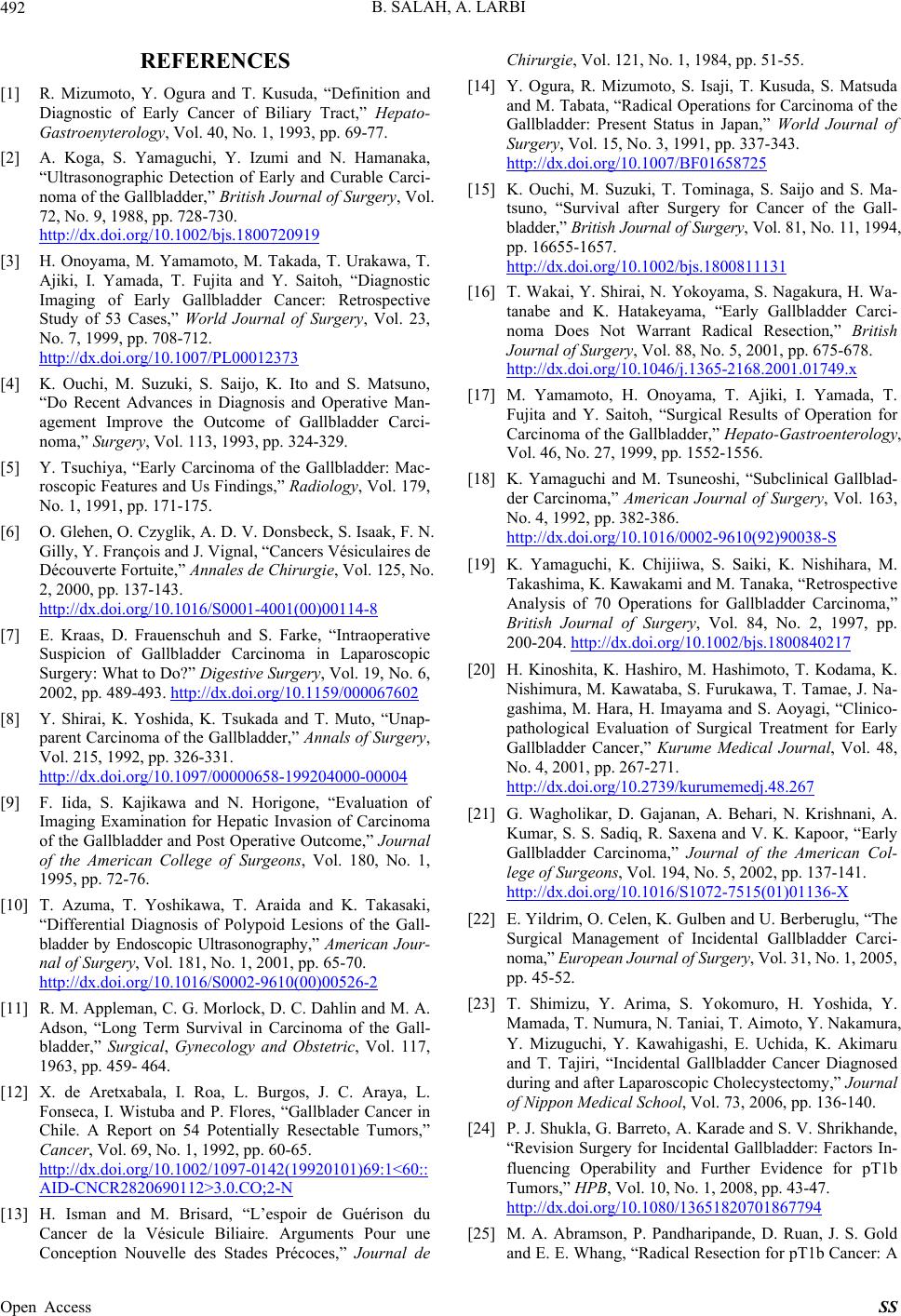
B. SALAH, A. LARBI
492
REFERENCES
[1] R. Mizumoto, Y. Ogura and T. Kusuda, “Definition and
Diagnostic of Early Cancer of Biliary Tract,” Hepato-
Gastroenyterology, Vol. 40, No. 1, 1993, pp. 69-77.
[2] A. Koga, S. Yamaguchi, Y. Izumi and N. Hamanaka,
“Ultrasonographic Detection of Early and Curable Carci-
noma of the Gallbladder,” British Journal of Surgery, Vol.
72, No. 9, 1988, pp. 728-730.
http://dx.doi.org/10.1002/bjs.1800720919
[3] H. Onoyama, M. Yamamoto, M. Takada, T. Urakawa, T.
Ajiki, I. Yamada, T. Fujita and Y. Saitoh, “Diagnostic
Imaging of Early Gallbladder Cancer: Retrospective
Study of 53 Cases,” World Journal of Surgery, Vol. 23,
No. 7, 1999, pp. 708-712.
http://dx.doi.org/10.1007/PL00012373
[4] K. Ouchi, M. Suzuki, S. Saijo, K. Ito and S. Matsuno,
“Do Recent Advances in Diagnosis and Operative Man-
agement Improve the Outcome of Gallbladder Carci-
noma,” Surgery, Vol. 113, 1993, pp. 324-329.
[5] Y. Tsuchiya, “Early Carcinoma of the Gallbladder: Mac-
roscopic Features and Us Findings,” Radiology, Vol. 179,
No. 1, 1991, pp. 171-175.
[6] O. Glehen, O. Czyglik, A. D. V. Donsbeck, S. Isaak, F. N.
Gilly, Y. François and J. Vignal, “Cancers Vésiculaires de
Découverte Fortuite,” Annales de Chirurgie, Vol. 125, No.
2, 2000, pp. 137-143.
http://dx.doi.org/10.1016/S0001-4001(00)00114-8
[7] E. Kraas, D. Frauenschuh and S. Farke, “Intraoperative
Suspicion of Gallbladder Carcinoma in Laparoscopic
Surgery: What to Do?” Digestive Surgery, Vol. 19, No. 6,
2002, pp. 489-493. http://dx.doi.org/10.1159/000067602
[8] Y. Shirai, K. Yoshida, K. Tsukada and T. Muto, “Unap-
parent Carcinoma of the Gallbladder,” Annals of Surgery,
Vol. 215, 1992, pp. 326-331.
http://dx.doi.org/10.1097/00000658-199204000-00004
[9] F. Iida, S. Kajikawa and N. Horigone, “Evaluation of
Imaging Examination for Hepatic Invasion of Carcinoma
of the Gallbladder and Post Operative Outcome,” Journal
of the American College of Surgeons, Vol. 180, No. 1,
1995, pp. 72-76.
[10] T. Azuma, T. Yoshikawa, T. Araida and K. Takasaki,
“Differential Diagnosis of Polypoid Lesions of the Gall-
bladder by Endoscopic Ultrasonography,” American Jour-
nal of Surgery, Vol. 181, No. 1, 2001, pp. 65-70.
http://dx.doi.org/10.1016/S0002-9610(00)00526-2
[11] R. M. Appleman, C. G. Morlock, D. C. Dahlin and M. A.
Adson, “Long Term Survival in Carcinoma of the Gall-
bladder,” Surgical, Gynecology and Obstetric, Vol. 117,
1963, pp. 459- 464.
[12] X. de Aretxabala, I. Roa, L. Burgos, J. C. Araya, L.
Fonseca, I. Wistuba and P. Flores, “Gallblader Cancer in
Chile. A Report on 54 Potentially Resectable Tumors,”
Cancer, Vol. 69, No. 1, 1992, pp. 60-65.
http://dx.doi.org/10.1002/1097-0142(19920101)69:1<60::
AID-CNCR2820690112>3.0.CO;2-N
[13] H. Isman and M. Brisard, “L’espoir de Guérison du
Cancer de la Vésicule Biliaire. Arguments Pour une
Conception Nouvelle des Stades Précoces,” Journal de
Chirurgie, Vol. 121, No. 1, 1984, pp. 51-55.
[14] Y. Ogura, R. Mizumoto, S. Isaji, T. Kusuda, S. Matsuda
and M. Tabata, “Radical Operations for Carcinoma of the
Gallbladder: Present Status in Japan,” World Journal of
Surgery, Vol. 15, No. 3, 1991, pp. 337-343.
http://dx.doi.org/10.1007/BF01658725
[15] K. Ouchi, M. Suzuki, T. Tominaga, S. Saijo and S. Ma-
tsuno, “Survival after Surgery for Cancer of the Gall-
bladder,” Briti sh Journal of Surgery, Vol. 81, No. 11, 1994,
pp. 16655-1657.
http://dx.doi.org/10.1002/bjs.1800811131
[16] T. Wakai, Y. Shirai, N. Yokoyama, S. Nagakura, H. Wa-
tanabe and K. Hatakeyama, “Early Gallbladder Carci-
noma Does Not Warrant Radical Resection,” British
Journal of Surgery, Vol. 88, No. 5, 2001, pp. 675-678.
http://dx.doi.org/10.1046/j.1365-2168.2001.01749.x
[17] M. Yamamoto, H. Onoyama, T. Ajiki, I. Yamada, T.
Fujita and Y. Saitoh, “Surgical Results of Operation for
Carcinoma of the Gallbladder,” Hepato-Gastroenterology,
Vol. 46, No. 27, 1999, pp. 1552-1556.
[18] K. Yamaguchi and M. Tsuneoshi, “Subclinical Gallblad-
der Carcinoma,” American Journal of Surgery, Vol. 163,
No. 4, 1992, pp. 382-386.
http://dx.doi.org/10.1016/0002-9610(92)90038-S
[19] K. Yamaguchi, K. Chijiiwa, S. Saiki, K. Nishihara, M.
Takashima, K. Kawakami and M. Tanaka, “Retrospective
Analysis of 70 Operations for Gallbladder Carcinoma,”
British Journal of Surgery, Vol. 84, No. 2, 1997, pp.
200-204. http://dx.doi.org/10.1002/bjs.1800840217
[20] H. Kinoshita, K. Hashiro, M. Hashimoto, T. Kodama, K.
Nishimura, M. Kawataba, S. Furukawa, T. Tamae, J. Na-
gashima, M. Hara, H. Imayama and S. Aoyagi, “Clinico-
pathological Evaluation of Surgical Treatment for Early
Gallbladder Cancer,” Kurume Medical Journal, Vol. 48,
No. 4, 2001, pp. 267-271.
http://dx.doi.org/10.2739/kurumemedj.48.267
[21] G. Wagholikar, D. Gajanan, A. Behari, N. Krishnani, A.
Kumar, S. S. Sadiq, R. Saxena and V. K. Kapoor, “Early
Gallbladder Carcinoma,” Journal of the American Col-
lege of Surgeons, Vol. 194, No. 5, 2002, pp. 137-141.
http://dx.doi.org/10.1016/S1072-7515(01)01136-X
[22] E. Yildrim, O. Celen, K. Gulben and U. Berberuglu, “The
Surgical Management of Incidental Gallbladder Carci-
noma,” European Journal of Surgery, Vol. 31, N o . 1, 2005,
pp. 45-52.
[23] T. Shimizu, Y. Arima, S. Yokomuro, H. Yoshida, Y.
Mamada, T. Numura , N. Tania i, T. Aimoto, Y. Nakamura,
Y. Mizuguchi, Y. Kawahigashi, E. Uchida, K. Akimaru
and T. Tajiri, “Incidental Gallbladder Cancer Diagnosed
during and after Laparoscopic Cholecystectomy,” Journal
of Nippon Medical School, Vol. 73, 2006, pp. 136-140.
[24] P. J. Shukla, G. Barreto, A. Karade and S. V. Shrikhande,
“Revision Surgery for Incidental Gallbladder: Factors In-
fluencing Operability and Further Evidence for pT1b
Tumors,” HPB, Vol. 10, No. 1, 2008, pp. 43-47.
http://dx.doi.org/10.1080/13651820701867794
[25] M. A. Abramson, P. Pandharipande, D. Ruan, J. S. Gold
and E. E. Whang, “Radical Resection for pT1b Cancer: A
Open Access SS